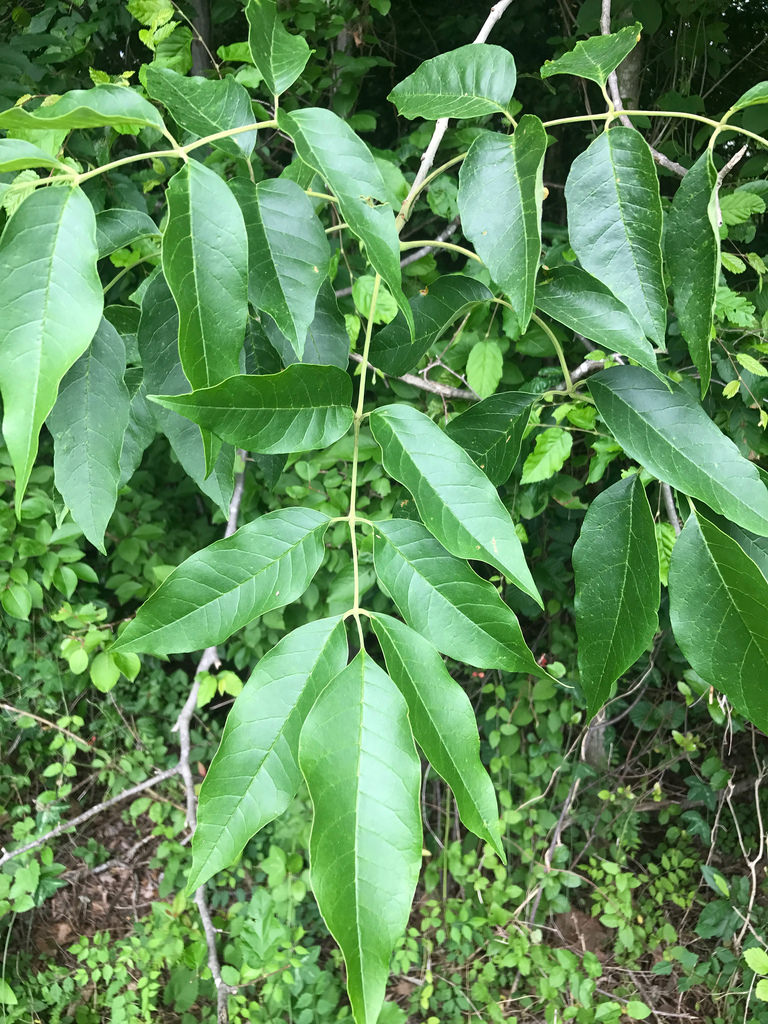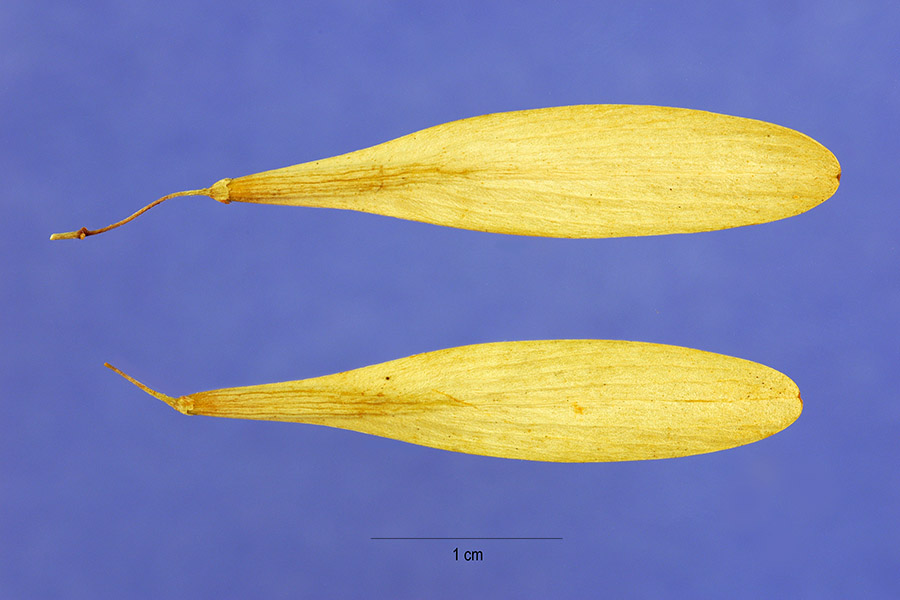Green Ash
Fraxinus pennsylvanica Marshall
Description
Green ash is a member of the olive family (Oleaceae) and is also called red ash, swamp ash and water ash 8. It is a deciduous hardwood that typically grows to a height between 50-75 feet, with a crown or 25 to 40 feet that can be rounded or Irregular ¹. Its bark is ashy-gray or brown with narrow ridges and the twigs are light gray 4. Leaves are arranged opposite from one another on branches² and are pinnately compound with 5 to 9 lance-shaped leaflets that are slightly serrated 8. Leaf petioles may be slightly harry distinguishing it from white ash. Flowers are small, inconspicuous and unisexual. The male flowers are less than 0.1 inch and have a calyx and a pair of stamens, but no petals. Female flowers have a calyx and a pistil with a single style. Female flowers that are wind- pollinated. Fruits are samaras, which have narrow, elongated wings and are 2 to 3 inches long 3. The wing of the samara extends one-half of the way down the seed distinguishing it from white ash where the wing does not extend down the seed.

Pinnae leaf of green Ash. J. Brighton, 2017, Maryland Biodiversity Project¹.

Samara of green ash showing wing going half way of seed. USDA 9.
Distribution
Green ash is the most widely distributed ash and prefers moist habitats 9. The tree grows in bottomlands and needs sun to thrive. Green ash is the most adaptable type of ash tree and can tolerate 15-60 inches of rain a year4. Green ash trees do not need a lot of sunlight, only 6 hours a day, so they can grow moderately in shaded areas like dense forests8. Green ash can be found all over Eastern North America. This range extends from Eastern Canada down through Texas and Florida6. In Maryland green ash grows nearly everywhere, excluding the western panhandle and far Eastern shore ¹.

Native distribution of green ash. USDA 4.
Wildlife Importance
Many wildlife utilize this species strong stout branches for nesting. It also provides food via seeds for species like the wood duck, cardinals, wild turkey, mice, fox and finches 2,3. Many other insects feed on the tree as well. Tiger Swallowtail, Brown-headed Ash Sawfly, and many other moth’s species caterpillars feed on the leaves 4. Deer will also feed on the foliage and twigs 4. The trees are utilized for roosting by numerous birds including Eastern Screech Owl, Cooper’s Hawk, Wild Turkey, Ruffed Grouse, and Common Grackle 4.
Economic Importance
This tree is commonly used for canoe paddles, replacing white ash ². This tree is useful in many specialty wood products, like tool handles, because it bends well. The wood of green ash trees is hard and has a high shock resistance, so it is used to make utility items like baseball or softball bats, electric guitars, and tool handles8. It is also used for landscaping in a variety of residential areas because it has few diseases and can grow in a variety of settings. Green ash has been used in reclamation of mining sites4.
Threats
The Emerald Ash Borer (Agrilus planipennis), an invasive species feeds on the wood of the tree by boring through it, is currently the largest threat to green ash. The Emerald Ash borer is native to Eastern Russia, Northern China, Japan, and Korea, where it rarely causes issues 6. However, in America they can kill an ash tree in 2 years and have killed millions of ash trees ². The Emerald Ash borer is metallic green, with a long flat back and around ½ inch long. The small white larvae will destroy the tree by burrowing into and eating the inner bark of the tree. The destruction of the trees inner bark cuts off its access to valuable nutrients and water. The crown will experience die back and the tree can eventually die if the infestation is not treated. Another strong indicator of an infestation is the D-shaped holes left 6. Other problems include fungal infections like the Mycosphaerella fraxinocola fungus that can cause leaves not to grow in young trees, or the rust fungal that can deform twigs and petioles, but these only damages the tree and do not kill like the beetle does².
Interesting Facts
- The Maryland champion green ash is in Cecil County and is 72 inches in diameter and 96 feet tall when last measured in 2017 10.
- Cattle and sheep also enjoy eating the twigs and foliage3.
- Beavers use the wood of saplings as a good source3.
- Can live up to 200 years! 3
References
- Maryland Biodiversity Project: Green ash
- USDA-NRCS Plant Guide: Green ash
- Arbor Day Foundation: Green ash
- Illinois Wildflowers: Green ash
- USDA-FS Silvics, Hardwoods: Fraxinus pennsylvania
- Emerald ash borer in Fairfax County
- Maryland Big Trees
- Tree Hugger: How to manage and identify green ash
- USDA Plants: Fraxinus pennsylvanica
